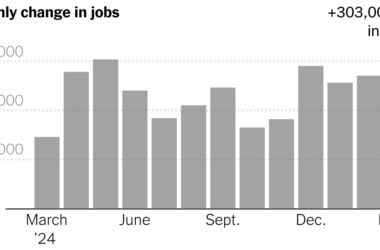Generally, the numerous numbers included within the authorities’s month-to-month jobs report come collectively to color a transparent, coherent image of the energy or weak spot of the U.S. labor market.
This isn’t a kind of occasions.
As a substitute, the information launched by the Labor Division on Friday was a multitude of conflicting indicators. It couldn’t even agree on essentially the most primary of questions: whether or not the financial system is including or shedding jobs.
The report confirmed that employers added 272,000 nonagricultural jobs in Might, way over forecasters had been anticipating. That determine relies on a survey of about 119,000 companies, nonprofit organizations and authorities businesses.
However the report additionally incorporates knowledge from one other survey, of about 60,000 households. That knowledge confirmed that the quantity of people that had been employed final month truly fell by 408,000, whereas the unemployment charge rose to 4 % for the primary time in additional than two years.
The 2 surveys measure barely various things. The employer survey consists of solely workers, for instance, whereas the family survey consists of unbiased contractors and self-employed staff. However that doesn’t clarify the discrepancy final month: Adjusting the family survey to align with the ideas used within the employer survey makes the job losses in Might look bigger, not smaller.
That signifies that the conflicting footage come all the way down to some mixture of measurement error and random noise. That’s irritating however commonplace: Over the long run, the 2 surveys typically inform comparable tales, however over shorter intervals they continuously diverge.
Economists sometimes put extra weight on the employer survey, which is far bigger and is mostly considered as extra dependable. However they aren’t certain which knowledge to imagine this time round. Some economists have argued that the family survey may very well be failing to seize absolutely the current wave of immigration, main it to undercount employment development. However others have argued that the employer survey may very well be overstating hiring as a result of it isn’t accounting correctly for current enterprise failures, amongst different components.




